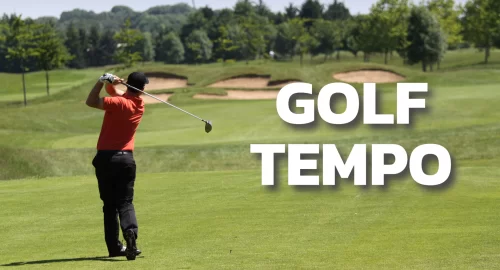
Practice and preparation are key when it comes to golf for beginners. You don’t want to be wasting time and energy worrying, overthinking, and trying to determine which shot to use when it’s crunch time.
These are the six golf shots every golf amateur should master, so you can have a consistent game and enjoy your time on the golf course with minimal mistakes!
While there are more specialty shots to learn – like hitting fades vs. draws, flops shots, etc. – these are the most essential (and necessary) golf shots for beginners.
Don’t forget, golf is all about the basics. You can always add in more advanced golf shots as you progress in your golf journey.
The 6 Most Important Golf Shots for Beginners
Today, we’ll keep it simple and go over the six common golf shots all beginners should have in their back pocket. Whether it’s off the tee or on the green, these shots can hopefully help you score well, and even break 90!
“The fundamentals of golf are no secret. They are the same for all golfers and have been for centuries.” – Jack Nicklaus
1. Your Go-To Driver Shot
The driver is one of the two most important clubs in the bag (alongside your putter). Yet, most everyday golfers struggle with the golf driver for a few reasons.
First, it’s the longest club, which means the hardest to hit consistently straight and can lead to big misses (a slice for most golfers). It’s also the lowest loft, which requires the most speed to maximize distance.
Here are a few tips to hit your driver longer and straighter:
- Play a fade or draw consistently, regardless of hole design.
- Focus on getting your lead shoulder underneath your chin for a full backswing.
- Have a slightly wider than shoulder width stance with the ball positioned off your front heel.
If you’re still struggling with a slice, the SF1 Performance driver is a great option for beginners. This one-of-a-kind club makes hitting a straight shot or controlled cut easy, without changing your swing. If you’re not flexible enough yet to hit a driver consistently well, consider these golf stretches.
Be sure to practice, practice, practice, so both your mental and muscle memory can help replicate the same driver shot every time.
For some tips on how to improve your golf swing with a driver from a pro, check out this video!
2. Punch Shot
No matter how good you get with a driver or 3-wood, sometimes missing fairways is just part of the game. This is why you need to develop a punch shot to escape trouble and get back into position.
A punch shot goes lower than normal at a fraction of the distance. With a few changes at setup, you can lower the trajectory to avoid low-hanging branches when they may otherwise obstruct your shot.
Here’s how to hit a punch shot with ease:
- Grab mid to longer iron as they have less loft (typically a 4, 5, or 6-iron, depending on your set).
- Choke up 1–2 inches to shorten the club and place the ball in the middle of your stance.
- Take a 3/4 backswing (or less if you need to hit it lower) and focus on a shorter follow through. The less you follow through, the lower the ball will go and hopefully avoid any pesky tree troubles.
Also, make sure to have a consistent tempo on these shots, as most golfers tend to rush it.
3. Stock Iron Shot
Once you get off the tee consistently, it’s time to focus on developing a stock iron shot. A stock shot is a shot that starts in one direction, curves back towards the line, but doesn’t overshoot the target. Similar to a driver, you want to keep it as one-dimensional as possible, favoring a fade or draw on every swing.
Playing one stock shot will make your practice time more beneficial and hopefully result in less penalizing misses on the golf course. As you get more advanced, you can work on changing trajectories and/or curving the golf ball.
For a consistent iron shot, focus on these two fundamentals:
- Ball position: The longer the iron, the more forward in your stance, but not where you place fairway woods. While shorter irons and wedges should be more toward the middle to create crisp contact.
- Alignment: Make sure your feet, hips, and shoulders are aligned toward your target to avoid developing any bad habits.
This video also has an easy drill to help you strike irons pure.
4. Chip Shot
Now that we’ve covered three of the longer golf shots all beginners need to master, let’s get into some short game fundamentals. First, you need to develop a consistent chip shot for when you miss the greens.
A chip is different from a pitch, as it’s meant to hit the green and then release like a putt. A pitch is a higher shot that’s intended to hit and stop on the greens quickly.
The good news is that chipping is very similar to putting and is easy to learn. Here’s how to hit this beginner golf shot:
- Grab a pitching or gap wedge and choke up 1.5-2 inches.
- Take a narrow stance with more weight on your lead leg and stand closer to the ball so you’re more upright.
- Standing closer allows you to make a putting like stroke for a simple chip.
The ball should hit and roll on the green like a putt.
5. Bunker Shot
While most amateurs struggle with a driver, a bunker shot is arguably the second most difficult.
To hit it consistently well out of the bunkers, remember this – you do not hit the ball on these shots! Instead, you hit the sand, which carries the ball out of the bunker. You can practice this without a golf ball, by drawing a small circle in the sand where the ball would be, and practice focusing on the sand and hitting that target instead. Then, you can start incorporating the ball as well.
Here are the basics to escaping the sand in one shot:
- Use your most lofted wedge (a sand or lob wedge).
- Open the face of the club and play the ball middle-front of your stance.
- Focus on hinging your wrists quickly and swinging with plenty of speed.
If your short game needs help, consider The ONE Wedge. This one-of-a-kind wedge makes all short game shots easier and will help you scramble like a pro.
6. Lag Putting
When it comes to the final shot, all beginner golfers need is lag putting.
In most cases, putting represents 30-40% of all shots during the round, with lag putts making up a significant portion. If you want to break 90 and better, getting the ball closer to the hole from long distances is key.
To become a good lag putter, you first need to learn how to read greens. Once you have a good read on the putt, then you want to focus on mechanics to build a repeatable putting stroke.
Here’s how:
- For longer putts, widen your stance slightly so you’re balanced and can make a bigger stroke.
- Make sure to keep your head steady so you make consistent contact and get the ball to the hole.
- Maintain a consistent tempo that you have to short or mid-length putts. The only thing that needs to change is the length of your stroke.
The Golf Shots Every Amateur Needs
If you can master these six beginner golf shots, you’re well on your way to scoring consistently! To learn more shaving strokes off your handicap, check out the Performance Golf Scratch Club to up your game, and be sure to browse our extensive library of helpful video tutorials from our team of expert coaches.

